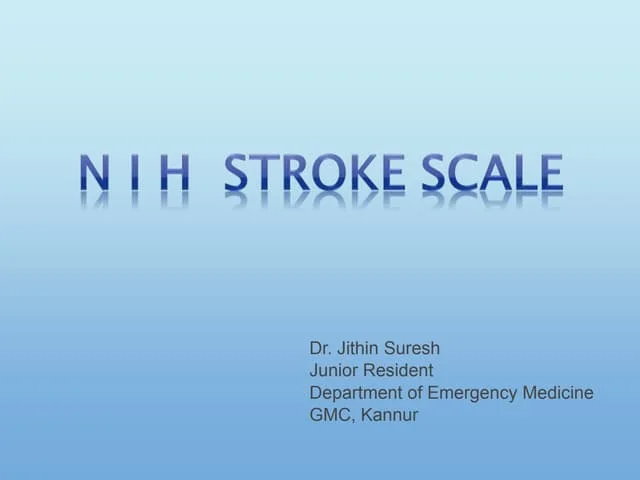Stroke Assessment Scales – NIHSS GCS
Assessing the Effect of Strokes: NIHSS and GCS Scales
Depending on the location and degree of the stroke, different parts of the brain are affected. Strokes are a major cause of disability and mortality globally. Precisely determining the severity of a stroke is essential for directing treatment choices and projecting possible results. The Glasgow Coma Scale (GCS) and the National Institutes of Health Stroke Scale (NIHSS) are the two major stroke measures that are covered in this blog post.
Table of Contents

Revealing the Effects of Stroke: Why Determine Severity?
A stroke severity assessment aids medical practitioners in:
- Assess the degree of brain damage; this informs therapy choices and aids in prognostication.
- Monitor progress over time: Track changes in scores over time to evaluate the degree of healing.
- Encourage dialogue amongst healthcare professionals: Consistent reporting and evaluation are guaranteed by standardized scales.
Stroke Assessment Scales – NIHSS GCS
The NIHSS and the GCS are two popular scales that are utilized for these objectives.
The National Institutes of Health Stroke Scale (NIHSS) is the gold standard.
The stroke severity assessment scale that is most frequently used is the NIHSS. This 15-point rating system assesses many areas of stroke-affected neurological function, such as:
- Level of consciousness: Response and alertness are evaluated.
- Eye movements: A test of visual cue following is conducted.
- Facial weakness: Symmetry and muscle strength are assessed.
- Motor function: Coordination and strength in the arms and legs are measured.
- Sensory function: Tests are conducted on the sense of touch and pain.
- Language function: Evaluation of speech production and comprehension is part of language function.
- Attention: The capacity for concentration and following directions is evaluated.
- Extinction: is the test of ignoring one side of the body.
Stroke Assessment Scales – NIHSS GCS
Based on performance, each segment is assigned a score; a higher number denotes a greater degree of impairment. Higher scores represent greater severity of neurological abnormalities, whereas a score of 0 indicates no deficits at all. The NIHSS provides a thorough picture of how different brain processes are affected by stroke.
Using the Glasgow Coma Scale (GCS) to Evaluate General Consciousness
The GCS is a more general neurological evaluation tool that is not stroke-specific. However, by determining the patient’s state of consciousness, it is useful in the evaluation of stroke patients. Three criteria are used by the GCS to determine score:
- Opening of the eyes: In response to discomfort, vocal commands, or spontaneous.
- Verbal response: Incoherent, disoriented, unsuitable words or noises, or silence.
- Motor response: Complies with instructions; withdraws from discomfort; localizes pain; exhibits aberrant flexion or extension.
Stroke Assessment Scales – NIHSS GCS
Depending on the version, each parameter has a score between 1-4 and 1-6; higher values correspond to better reaction. A patient who has a total score of 15 is considered fully alert; lower numbers indicate varied degrees of reduced consciousness. A lower GCS score could indicate a more serious brain injury, such as a stroke.
The GCS is not stroke-specific, but it does offer important information about a patient’s general reactivity, which can be a critical component of the stroke assessment process.
Combining Scales to Get a Better Image
Stroke Assessment Scales – NIHSS GCS
Together, the NIHSS and GCS provide a complete picture of the severity of stroke. When it comes to brain functions specifically affected by stroke, the NIHSS provides a thorough assessment, whereas the GCS evaluates general consciousness.
This is how they enhance one another:
- A low GCS score could be a sign of a serious stroke that has to be treated right away.
- A normal GCS score combined with a high NIHSS score indicates a stroke that affects certain brain functions but does not substantially change consciousness.
Stroke Assessment Scales – NIHSS GCS
Healthcare providers can better comprehend the effects of a stroke and adjust treatment by taking into account both measures.
Beyond Scores: Clinical Judgement’s Significance
Stroke Assessment Scales – NIHSS GCS
Stroke scales are useful instruments, but a doctor’s clinical judgment is still necessary. When determining prognosis and organizing care, variables such as a patient’s age, medical background, and pre-stroke functional ability are also crucial.
Stroke Assessment Scales – NIHSS GCS
Recall: Reducing brain damage and enhancing outcomes after strokes need early detection and treatment. Get medical help right away if you think you may be having a stroke.


